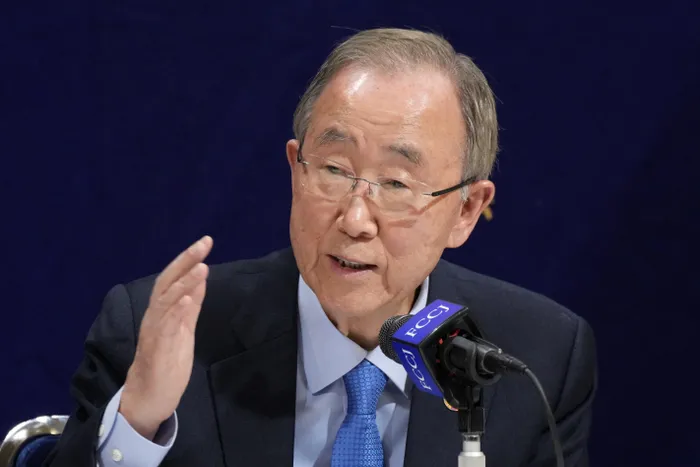The anatomy of decline: Unemployment and South Africa’s structural crisis
OPINION

Ban Ki-moon, former UN Secretary-General, reminds us that “addressing unemployment is not just an economic imperative, it is a moral and social one that defines the future of peace and progress
Image: AFP
In 1994, South Africa emerged from apartheid with global goodwill, democratic legitimacy and the promise of shared prosperity. Yet three decades later, that promise remains unfulfilled. With an overall unemployment rate of 31.9% and youth unemployment at 59.6% (Q4 2024, Stats SA), the country faces a structural crisis that is eroding its economic base and social cohesion.
This is not an isolated issue but a national reckoning that follows a pattern common to both collapsing companies and declining states. Jim Collins, in How the Mighty Fall, outlines five stages of institutional decline: hubris, undisciplined growth, denial of risk, superficial solutions and eventual stagnation. These stages offer a sobering framework for understanding South Africa’s current position.
“Denial is the most dangerous stage of decline,” Collins warns, “because it blinds leaders to reality.”
Stage 1: Hubris Born of Triumph
Between 2000 and 2008, South Africa enjoyed average GDP growth of 3.5%, buoyed by favourable commodity cycles and post-apartheid optimism. The country asserted its geopolitical presence, joined BRICS and positioned itself as a regional hub. But early success bred complacency. Rather than address long-standing structural inequalities or invest in productive capacity, economic momentum gave way to inertia.
The Gini coefficient remained high at 0.67 while labour market rigidities discouraged job creation. State-owned enterprises, particularly Eskom, were allowed to expand without accountability. By 2024, public bailouts for Eskom had surpassed R500 billion. Argentina’s early 20th-century trajectory offers a striking parallel: a commodity-rich economy that ascended rapidly only to decline due to internal mismanagement and premature confidence in global status.
South Africa’s early economic positioning masked unresolved domestic vulnerabilities. While attention turned outward to summits and regional diplomacy, the foundations beneath were quietly eroding.
Stage 2: The Undisciplined Pursuit of More
South Africa’s expansion of redistributive programmes, especially through social grants and state employment schemes, was not matched by corresponding economic productivity. The social grant system, projected to cost R259.3 billion by 2026, has been essential for poverty relief but increasingly burdens fiscal sustainability.
Meanwhile, core infrastructure suffered. Transnet’s freight efficiency declined sharply and energy supply instability continued to constrain investment. The World Bank reports average GDP growth of just 0.7% between 2014 and 2024. Yet state-led expansion persisted, often detached from output and institutional readiness.
This pursuit of scale without returns mirrors firms that chase growth for its own sake. Public employment expansion - while well intentioned - has in some cases reinforced dependency. The logic that more ‘boots on the ground’ equals delivery has led to overstaffing, rising wage costs and limited institutional agility. Government visibility has been confused with public value.
Climate risks have compounded the challenge. Extended droughts have reduced employment in agriculture and mining, weakening resilience in rural provinces. Without adaptation strategies, the employment impacts of environmental shocks will only intensify.
Stage 3: Denial of Risk and Erosion of Trust
Despite mounting evidence of institutional and economic strain, reforms have lagged. The Zondo Commission exposed over R500 billion in procurement-related losses, yet implementation remains slow. Labour market mismatches have worsened, with 42% of jobless individuals now classified as discouraged workers - those who have ceased to seek employment entirely.
Total Factor Productivity has declined for over 15 years according to the International Monetary Fund, yet public discourse often defaults to rebranding or extending existing models. Persistent mismatches between the education system and labour market needs further entrench youth unemployment. Over a million students are enrolled in post-secondary institutions annually, yet far fewer graduate with skills aligned to economic opportunity. Technical and vocational education remains underfunded despite strong global evidence of its employment impact.Trust in government has declined.
According to the Edelman Trust Barometer, only 22% of South Africans express trust in government compared to 62% in business. Many young people are now cycling through training schemes with no connection to employment. For them, the crisis is not theoretical - it is lived daily through delayed adulthood and social alienation.
Stage 4: Superficial Solutions and Fiscal Pressure
Short-term relief measures have become the norm. The Social Relief of Distress Grant and other temporary interventions offer necessary support but are not substitutes for structural employment generation. Public debt now stands at over 74% of GDP, edging towards unsustainable territory. The 2024 Budget Review confirmsdebt service costs are rising faster than allocations to education and infrastructure.
Some initiatives under Operation Vulindlela and the Just Energy Transition Investment Plan show intent but require stronger execution and sustained coordination.Technology adds further pressure. McKinsey estimates that automation could displace one in four jobs in South Africa by 2030, especially among low-skilled workers. Without a reskilling strategy, digital transformation may reinforce unemployment rather than resolve it.
The African Development Bank warns that the continent adds 10 million job seekers to the labour force annually but creates only 3 million jobs. Grants and temporary schemes cannot bridge this gap. They must be paired with pathways into the formal economy - particularly for youth, women and small businesses.The private sector must also adapt. Hiring practices, investment in entry-level talent and support for smallenterprises are necessary components of a functioning labour market.
Stage 5: Recovery or Regression?
South Africa remains at a critical juncture. Continued economic stagnation if unaddressed could normalise exclusion and dampen democratic participation. But recovery is not out of reach.
Post-crisis recoveries in South Korea and post-war Germany show what is possible when discipline, targeted investment and reform align. In South Africa, green shoots exist. TymeBank has expanded financial inclusion through low-cost digital banking. Harambee Youth Employment Accelerator has supported over a million workseekers using demand-driven matching.
AfCFTA implementation offers a strategic lever. If logistics and regulatory reform accompany it, the agreement could boost Africa’s income by $450 billion (R7.9 trillion) by 2035. For South Africa, increased participation in regional manufacturing and agri-processing could transform employment patterns - particularly in secondary cities andrural districts.
The informal economy, where most African employment resides, cannot be ignored. It requires accessible microfinance, simplified registration and recognition as a legitimate growth engine. Development cannot occur if the majority of economic activity is treated as marginal.
None of this is possible without confronting inefficiencies in how public funds are deployed. While social grants and public employment programmes are essential lifelines for vulnerable populations, they have not translated into economic inclusion. Expanding headcounts in state departments is sometimes used as a proxy forperformance, yet without addressing institutional inefficiencies, this risks reinforcing dependency.
Employment must become the central metric of public accountability.
Conclusion: The Stakes and the Path Forward
Failing to address unemployment is not a challenge that can be deferred without consequence. Beyond economic metrics lie the very fabric of social stability, public trust and democratic legitimacy. South Africa’s experience offers a warning to all emerging and developing economies: the cost of delay is measured not only in GDP but in fractured communities and lost futures.
Ban Ki-moon, former UN Secretary-General, reminds us that “addressing unemployment is not just an economic imperative, it is a moral and social one that defines the future of peace and progress.”
South Africa is not alone. Across emerging economies, unemployment, fiscal strain and youth disillusionment are converging into systemic risk. The lessons embedded in this crisis - about political will, economic realism and institutional reform - are applicable far beyond one nation’s borders.
The foundations for recovery exist but require clear-eyed leadership and a willingness to prioritise structural reform over symbolic intervention. South Africa’s story will be determined not by its past but by how decisivelyit addresses the challenges of today.

Nomvula Zeldah Mabuza is a Risk Governance and Compliance Specialist with extensive experience in strategic risk and industrial operations. She holds a Diploma in Business Management (Accounting) from Brunel University, UK, and is an MBA candidate at Henley Business School, South Africa.
Image: Supplied
Nomvula Zeldah Mabuza is a Risk Governance and Compliance Specialist with extensive experience in strategic risk and industrial operations. She holds a Diploma in Business Management (Accounting) from Brunel University, UK, and is an MBA candidate at Henley Business School, South Africa.
BUSINESS REPORT